Finding a killer application for e-textiles is the realm of the hacker and within that realm, anything goes. Whether it’s protecting your digital privacy with signal shielding, generating audio with a wearable BeagleBone or 555 timer, or making your favorite garment into an antenna, the eTextile Spring Break is testing out ways to combine electronics and fabric.
You may be asking yourself “What are e-textiles good for?”. Well, that’s an excellent question and likely the most common one facing the industry today. I’m afraid I won’t be able to give a definitive answer. As an e-textile practitioner, I too am constantly posing this question to myself. There’s an inherently personal nature to fabric worn on the body and to our electronic devices that makes this answer elusive. Instead of trying to fabricate some narrow definition, what I offer is a look at topics of interest, material experimentation, and technical exploration through the lens of a week-long event held recently in New York called eTextile Spring Break.
eTextile Spring Break
Outside of the market’s influence, there is a special event that happens once a year in rural France. One where e-textile practitioners and wool punks get together to discuss and create amongst conductive fiber and gallons of wine. This event is called eTextile SummerCamp. eTextile Spring Break is a spin-off of SummerCamp fostering a community surrounding e-textiles in the United States. I had the pleasure of being a co-organizer of the event with three other women and am going to share some of the work I saw while I was running around as both an organizer and participant.
E-textiles as Performative Conduits and Sound Generation
E-textiles can be an interesting solution for experimental instrument design and provide a fun output for performers and non-performers alike. Technically speaking, there are lots of options for noise generation when looking to build a musical piece. Two workshops at eTextile Spring Break covered a high tech option while the other covered relatively low-tech ones.
BeagleBone on a Garment
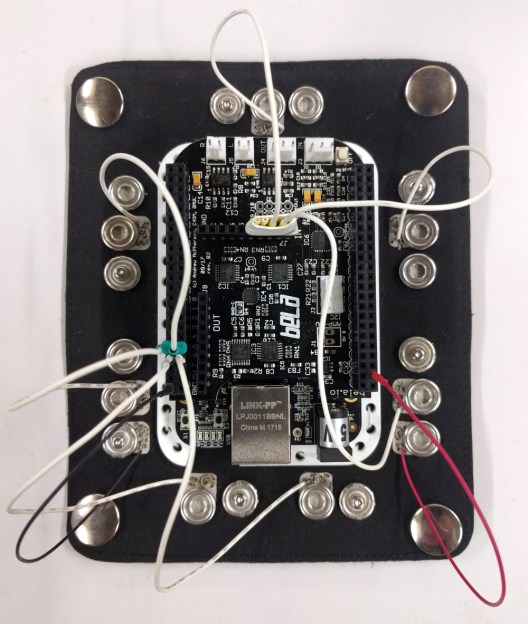
Becky Stewart taught a workshop called Intro to Audio Processing with the Bela, a platform which is specifically designed for ultra-low-latency audio processing. Bela combines a browser-based IDE with a cape for the BeagleBone Black. The newest version of this hardware is shown here. Called the Bela Mini, this board is a shield for the PocketBeagle.
In collaboration with Sophie Skach and An Liang, Becky is building a wearable prototyping platform called Embelashed. The system includes a fabric-based controller board for Bela, stretch sensors and switches made from conductive and resistive fabrics, with conductive fabric to connect components.
The workshop went over C++ examples and Pure Data patches that are included in the IDE, and some Pure Data patches which Becky created specifically for wearable applications. You can check out the wiki on the Embelashed repository for more examples introduced during the workshop. If you want to know a bit more about the connections being broken out on the fabric breakout shown above, Becky also has a labelled version of the image.
Iron-On and CNC Cut Circuits
Martin De Bie and Adrian Freed led a workshop that revolved around sound generation and manipulation using microcontrollers and the 555 timer IC.
Martin led the construction of an iron-on conductive fabric breakout for the 555 that he and Adrian developed. The circuit is designed with interdigitating pads allowing you to place your fingers where resistors commonly go in 555 timer oscillator circuits. Martin and Adrian went through a few iterations of the circuit design while at Spring Break. CNC cutting each iteration from either conductive fabric and copper tape using a Silhouette CAMEO. Read more about their designs on Martin’s Github and Adrian’s website.
Shielding Signals with E-Textiles
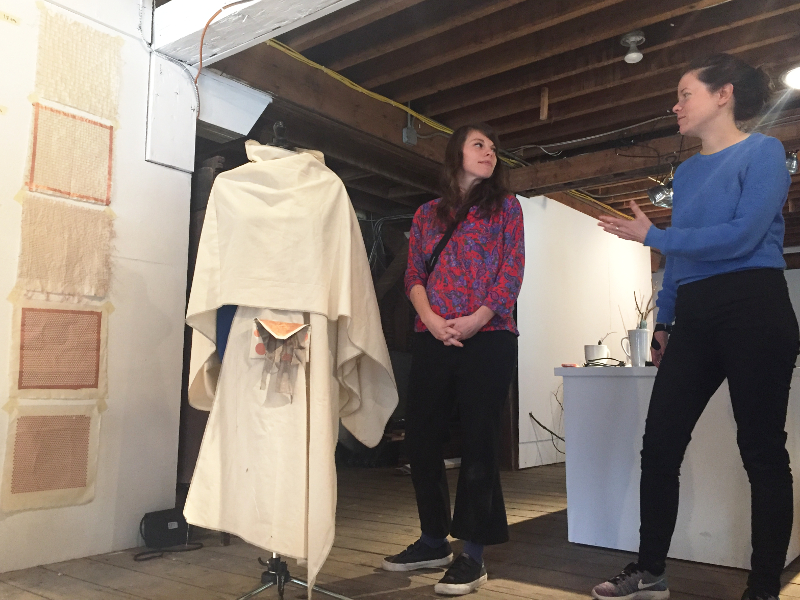
We live in a world of connected devices that wirelessly transmit data using radio waves. Cell phones are rarely turned off and radios designed to transmit and receive are ending up in all kinds of consumer products. These radiations concern people not only because of the debate around whether they do physical harm (radiation sickness) but also the question of surveillance comes up. What information is being passed between all these connected devices and as a counterpoint, can we block the potential invasion from incoming transmissions that trigger an unwanted burst of personal data outgoing from a device?
As part of the Hard Privacy in a Soft World focus group, Liza Stark and Irene Posch researched and explored ways to block radio waves by designing patterns of electrically conductive textiles. The Faraday cage inspired swatches they built are still in the testing stage and were not functioning at the end of the event. Still, the patterns are striking and the notion of aesthetics driven by the necessity to block radiations intriguing.
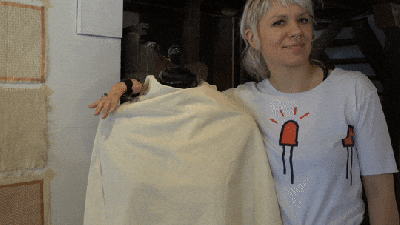
Liza and Irene also explored the notion of visualizing the transference of wireless energy. With a wave of a hand, they lit up an LED on a garment transmitting the power from one induction coil to another. This illustrates the concept of being notified when an outside signal is directed towards you. Imagine a future where what your wearing reacts to the stray RF in your vicinity.
The actuating side of the circuit was built into a garment designed as one large Faraday cage. Designed so one could zip their whole body up in order to shield oneself from radio waves. The design had a nomadic feel to it with its voluminous cut and functional pockets.
Intra-body PANs and Wearable Antennas
Wireless transmissions continued to hold a strong presence at eTextile Spring Break. Participants brought current research on e-textile antennas and built new ones along with transmitter and receiver circuits for a variety of bandwidths.
FM Radio Transmitters and Conductive Fiber Antennas
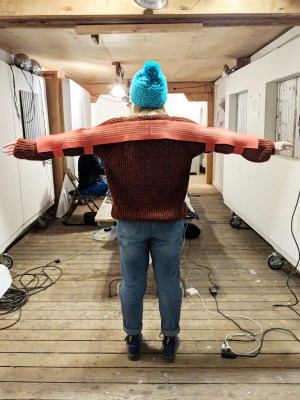
The Revel off the Grid focus group built parts to a DIY communication network including FM and AM transmitters, receivers, and textile-based antennas. All wearable antennas were based on previous designs found in a research paper by Paolo Nepa and Hendrik Rogier. A dipole and helical antenna design from the paper were crafted into wearable antennas using conductive fabrics and thread. The first being a symmetrical four-finger design created by Afroditi Psarra who does a lot of antenna research of her own.
This four-finger antenna was connected to an FM receiver found on a shelf at The Wassaic Project. The second antenna design was used for two FM transmitters built using 555 timers. They were comprised of a coil balanced with a straight counterpoise with the signal feed placed in the middle. Sam Topley, one of five members of the group decided to forge her own path by creating a conductive pom-pom antenna (see below) mixing neutral and conductive yarns and thread.
The antennas weren’t the only thing to get an e-textile treatment. Nicole Messier and Sam created their transmitter circuits from CNC cut iron-on conductive fabric and hand stitched conductive thread respectively. The Revel off the Grid focus group’s explorations culminated in a performance of sorts. The wearable antennas provided motivation for movement as the wearers played with distance while looking for the strongest signal as the handbuilt FM transmitter circuits pulsed microphone input towards the FM receiver.
RFID and Personal Area Networks
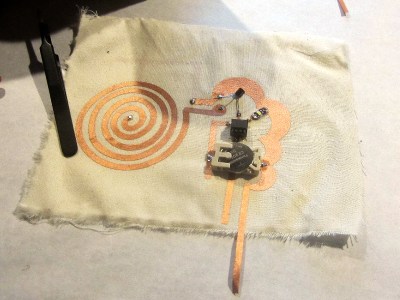
RFID and near-field intra-body communication devices were other wireless technologies covered in a workshop led by Nicole Messier and Ingo Randolf. Nicole guided students through an RFID transmitter circuit and antenna built to be used with the Adafruit’s PN532 NFC/RFID Arduino shield.
Ingo Randolf showed students how to build a receiver and transmitter circuit in order to transmit data through a body by capacitive coupling. The circuits are based on a paper written by Thomas Guthrie Zimmerman in 1995. How does it work? Here is a synopsis taken from Zimmerman’s paper:
“A near-field intra-body PAN (Personal Area Network) is a wireless communication system that allows electronic devices on and near the human body to exchange digital information through near-field electrostatic coupling. Information is transmitted by modulating electric fields and electrostatically (capactively) coupling picoamp currents into the body. The body conducts the tiny current (e.g., 50 pA) to body mounted receivers. The environment (“room ground”) provides a return path for the transmitted signal. A low frequency carrier (e.g., 330 kHz) is used so no energy is propagated, minimizing remote eavesdropping and interference by neighboring PANs. Digital information is transferred using on-off keying using a simple serial-data protocol similar to RS232.”
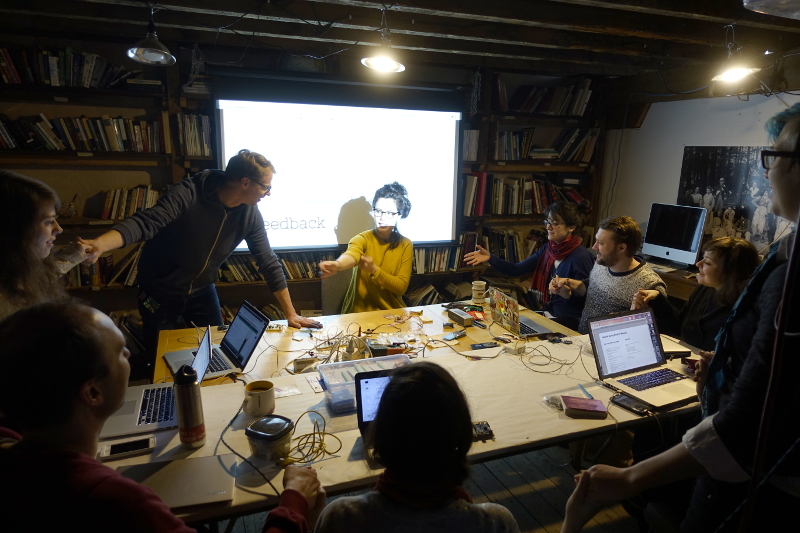
On his website, Ingo offers the circuit diagrams and code as well as pointing out how it can be useful when designing with e-textiles and wearable electronics:
“Using the body as a communication channel is an interesting approach to send sensors-data from one part of the body to another part of the body – or to another body. This may be very useful for e-textile projects. Especially when it is not possible to use conductive material to transmit data.”
Building a Community With and Around E-textiles
eTextile Spring Break is not only about fostering a community of practitioners. It’s also about reaching out to communities after we’ve all gone home. At the end of the week, the eTextile Spring Break Social opened The Wassaic Project’s door to the public. At the event, people read about participants’ work on display including what had been created throughout the week. There were workshops and activities like Knit Ur Face with Audrey Briot and Martin De Bie, needle felting with Ingo Randolf, and screen printing with thermochromic and photochromic inks with Pauline Vierne and Sasha de Koninck.
I’ve learned that e-textiles can lower the barrier of entry to demographics of people who would normally be intimidated or discouraged to learn electronic circuit building such as women and young girls. It enforces engineering principles with traditional craft which creates bridges between unexpected groups of people and interests. E-textiles is a wonderful blend of old and new technology and before you know it you may be learning how to knit while making noise music.
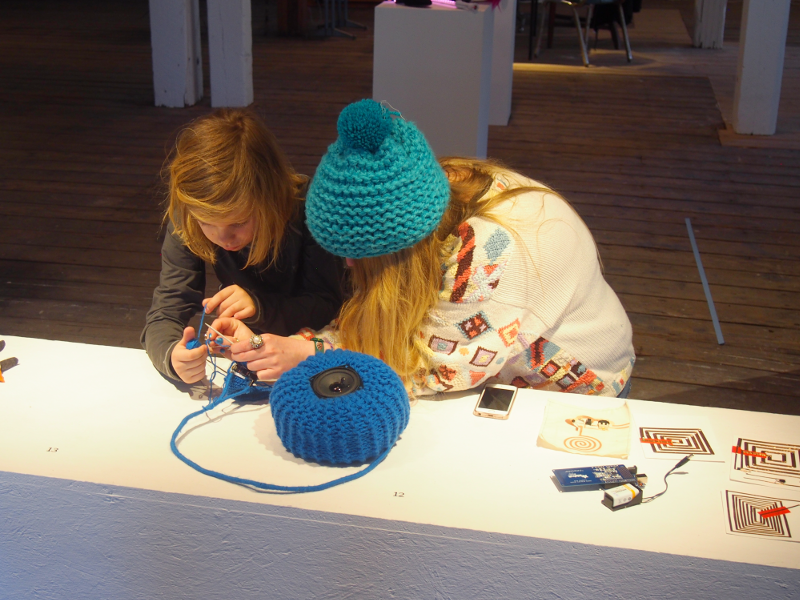
[Main image credit: Sam Topley]

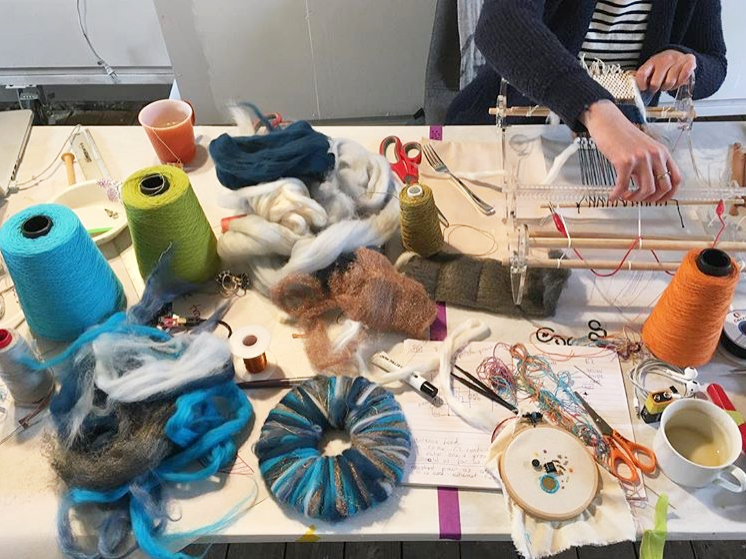





























“You may be asking yourself “What are e-textiles good for?”.”
I for one, am glad someone is asking the question!
Thanks for the article.
It’s definitely a question worth asking. Until someone makes a practical invisibility cloak.
On a more serious – or at least more attainable – goal, I wouldn’t mind having a mountain bike suit with active cooling and transducers to log my vital signs.
The killer app for conductive textiles is taser blocking for people who want to avoid shocking experiences with pursuers
Inre: Knitting your face
Be sure to weave in bright LEDs for your eyes!
B^)
When I first saw the name “Ingo”, I thought of its opposite, “Outcome”.
B^)
Lot of fiction has intelligent cameo, where “blending in” really means something.
Thanks for your great review of this wild, creative, productive and fun camp. Many of the projects are being documented in people’s blogs and linked from the camp web site.
Unless the clothing is robust enough to be worn many times and is washable, then can be recycled or composted without heavy metal contamination issues (copper. silver, etc.) it is ecologically unsound and should be discouraged. This does raise the bar a lot but there are carbon fibres and graphite impregnated fibres as well as organic polymers etc.
“We live in a world of connected devices that wirelessly transmit data using radio waves. Cell phones are rarely turned off and radios designed to transmit and receive are ending up in all kinds of consumer products. These radiations concern people not only because of the debate around whether they do physical harm (radiation sickness) …”
I’m sorry, what? This line made me do a double take. Who wrote this? Electromagnetic radiation is not the same as something being radioactive. Are we a mainstream news site?
There are physiological effects from radio waves and other EM radiation just as there are from radioactivity. They are simply not as extreme or as well-known as those from radioactivity because most radio waves you will be exposed to are of sufficiently low level as to be harmless.
There are people with real and demonstrable problems with RF, I’m instantly thinking of a radio amateur I used to know who got headaches if he used a 70cm handheld. But there are also a number of people and groups of the tinfoil hat variety who have picked up upon it, and maybe that’s given the subject a bit of a bad name.
I am somewhat envious upon reading this piece, I wish it had been on my side of the Atlantic.
Jenny, Fibre East is not only on your side of the atlantic but on your side of the UK too.
Do you think it would be a good venue for an e-textile workshop ?
This has inspired me with a few ideas:
Use the personal network idea to form groups, and have some sort of feedback system to reacts when you nearer/further, or when sensors are triggered.
A.Your kid starts to wander off, their shirt starts beeping. They get further out of range, a vibration on your arm tells you they’re about 60 degrees to your right. Further still, a GPS beacon activates and communicates with your cellphone.
B.You’re on vacation, and you’ve gotten hopelessly separated from your friend. You look down at the 2 RGB LEDs on your sleeve, they’re just a few shops away, on the left.
C. Your friend heads outside to get something from the car. A little while after they leave, your cellphone alerts you that your friend may be in trouble (pressure sensors in sleeve calibrated to activate at high pressure, sensor near the neck that detect sudden fast movement of the neck, etc), allowing you to get help.
Just some random thoughts.